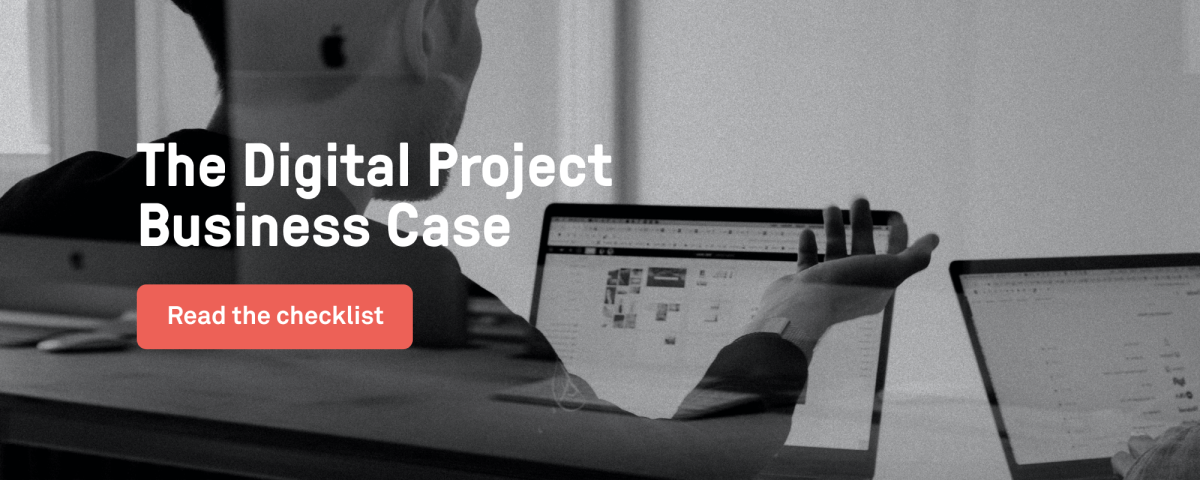
How to build a business case for your new website project
Building a business case will help convince your management to invest in a new CMS or new digital project.
Written by Vegard Ottervig on
When you commence a new digital project, you need to know the benefits and limitations of the proposed change. You must also learn how to communicate these effects to your organization, and you’ll get all this knowledge from a well thought out business case.
The business case is one of the first things you do in a project and outlines the necessary elements needed to decide if the project is worth giving a shot, writes The Digital Project Manager. The elements to be assessed are the business problem or opportunity, benefits, risks, costs, proposed technical solutions, timescale, operational impact, and required capacity.
Now let’s see how you make a business case for your digital experiences from start to finish.
Learn the anatomy of a business case with our guide:
How to write a business case
First and foremost the document should be brief. Less is more and the more essential you can write, the happier your management will be. Keep your copy interesting, clear, and concise, while at the same time eliminate conjecture and jargon.
Describe your vision of the future and demonstrate the value and benefits the project brings to the business whenever you get the chance. Also create standard operating procedure checklists for a clear view of your business goals.
Potential contents
What parts should you include in a brief and concise business case? Upside Energy suggests among the following:
- Executive summary
- Situation
- Benefits (financial and non-financial)
- Proposed solutions
- Impacts
- Outline plan
- Market assessment
- Governance
- Financial analysis
- Risks assessment
What you end up with in the finished business case is up to you, but it should in any case reflect the real needs of your organization and the requirements in the specific digital project.
We’ll now take a closer look at the six most essential parts.
1. Executive summary
In this part all the essentials of the business case are listed. Most executives are busy people, so adding a page with a neat summary may do wonders for your digital project actually being considered.
Here you will list what issues you want to address, what goal you want to reach in order to address the issues, what benefits the organization will get from this, and what concrete actions you will undertake.
2. Benefits and limitations
According to Workfront, a business case should include a part for benefits and limitations of the new project, describing both financial and other benefits. Explain why you need new digital experiences, as they might e.g.:
- Save cost through efficiency
- Improve long term quality
- Help generate more revenue
- Keep you competitive
- Improve customer service
- Align to your organization’s purpose and strategy
3. Proposed solutions
In this section you will identify the potential solutions to your problem and describe them in enough detail for your stakeholders to understand. In your case, this will probably be a new CMS or digital experience platform.
Keep a short list of around three to five options, ranging from a “do nothing” to a benchmarking alternative. Explain what the different solutions do and how they do it, while highlighting strengths and weaknesses.
Don't miss the next big thing: Supercharge your site with Next.js and headless CMS »
4. Outline plan
An outline plan is ideally a documentation of implementation approach, timeline, and resources needed. The process of the project is best divided into stages, where key decisions precede each stage.
In the plan you answer questions like: What is required? How is it done? Who does what? When will things happen? The timeline will function like your recipe, especially when combined with a list of resources needed—like financial, human, and specialist equipment.
A plan is an excellent opportunity for you to demonstrate your ability and willpower to deliver the solution!
5. Market assessment
You can probably imagine that it’s not too clever to go on a vacation in a strange country without any sort of planning or briefing in advance. This principle applies to almost anything and especially your industry. Assessing the market is a required factor in keeping up with both your competitors and the general tendency of the business as a whole.
In a market assessment you should provide a thorough analysis of the business context and make the underlying business interests explicit. If you consider political, economic, sociological, technological, and legal factors, you show your stakeholders that you have a thorough understanding or awareness of the marketplace.
Find out more: The skills you need to build successful digital experiences »
6. Risk assessment
Reality is rarely a bed of roses all the time—and neither is the world of digital experiences. There are potential risks in choosing new digital systems and it is your responsibility to discover and mitigate them before you commence your project.
In the section of risk assessment you can summarize all the significant risks and opportunities, as well as how they will be managed. The risks can stem from your project itself or be caused by your organization’s ability (or lack thereof) to adapt to change.
Identify the particular risks and sketch out the probable consequences if a risk should happen. Also include a plan for how to deal with potential risks. The same principle goes for opportunities.
***
The purpose of a business case is to provide your organization with the reasons for why they should support your digital project and to hand you a tool for ongoing evaluation of it. Don’t make it harder than it has to be—teach yourself to think in essentials in order to deliver the most direct and compelling business case for new digital experiences.
First published 29 October 2018, updated 9 August 2022.

